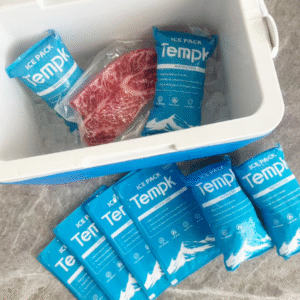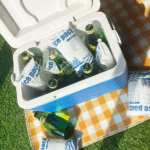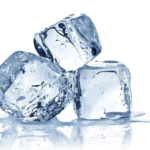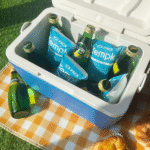Como os sacos de gelo seco isolados protegem suas remessas?
Se você está enviando comida congelada ou produtos farmacêuticos, um insulated dry ice bag can be a game‑changer. These specialized bags are engineered to maintain ultra‑low temperatures for extended periods by slowing the sublimation of dry ice and allowing CO₂ gas to escape safely. This guide explains how they work, Por que eles importam, and how you can use them to keep products safe in transit while complying with 2025’s cold chain regulations. You’ll also learn how to select the right bag, handle dry ice safely, and stay ahead of emerging industry trends.
-
What makes an insulated dry ice bag different from ordinary coolers?
-
How to choose the right bag size, material, and insulation level?
-
Safety tips for handling dry ice and preventing frostbite, including proper ventilation and protective gear.
-
Emerging innovations in 2025, such as eco‑friendly materials and smart sensors.
-
Frequently asked questions and actionable advice for using dry ice bags effectively.
Why are insulated dry ice bags essential for cold chain logistics?
In a nutshell: Insulated dry ice bags maintain ultra‑low temperatures by controlling the sublimation of dry ice and venting CO₂ gas safely. This makes them indispensable for shipping frozen goods, produtos farmacêuticos, e amostras biológicas. Ao contrário do gelo tradicional, dry ice sublimates directly from solid to gas at –78.5 °C (–109,3°F), não deixando nenhum resíduo de água. The bag’s insulation slows this process and prevents pressure build‑up, extending cooling time and protecting the contents from direct contact with dry ice.
Explicação estendida: Quando o gelo seco sublima, it releases CO₂ gas that can displace oxygen in a confined space. A well‑designed bag is vented so CO₂ can escape, preventing dangerous pressure build‑up. Materials such as durable polyethylene, polypropylene and foam create a barrier that resists tears and withstands extreme cold. Multi‑layer construction increases insulation and durability, while some bags incorporate vacuum‑insulated panels or aerogels for longer hold times. These features make insulated dry ice bags a reliable tool for temperature‑sensitive shipments, allowing you to maintain product integrity without the mess of melted ice.
How do insulated bags compare to regular coolers or gel packs?
Key details: Unlike foam coolers or gel packs, an insulated dry ice bag keeps temperatures near –78.5 °C and lasts longer. In a comparison of dry ice bags, gel packs and phase‑change materials, dry ice bags maintain –109 °F (–78,5 ° C.) for up to 24–72 hours, whereas gel packs only maintain 0–10 °C for 24–48 hours. They also leave no water residue because dry ice sublimates into gas. No entanto, gel packs are better for shipments that must not freeze, while dry ice is suited for products that can withstand freezing temperatures like ice cream and frozen meat.
| Método de resfriamento | Faixa de temperatura | Duração | Melhor uso | O que isso significa para você |
|---|---|---|---|---|
| Saco de gelo seco | -78,5 ° C. (−109°F) | 24–72h | Alimentos congelados, produtos farmacêuticos, Biologics | Keeps items deeply frozen for long durations without water mess |
| Pacote de gel | 0–10 ° C. (32–50°F) | 24–48h | Kits de refeições, mantimentos, itens sensíveis | Maintains chilled temperatures but not freezing; safe for items that cannot freeze |
| Material de mudança de fase | Personalizável (0 ° c, -20 ° C.) | 48–96h | Cargas mistas, both chilled and frozen items | Offers flexibility and longer duration but at higher cost |
Dicas práticas e recomendações
-
Selecting bag size: Choose a bag size that matches your payload. Bags range from small (7 × 13 in) for 10–20 quart coolers to large (15 × 20 in) for long‑haul shipments. Oversized bags waste dry ice; undersized bags risk insufficient cooling.
-
Check material quality: Look for polyethylene or polypropylene bags that resist tears and punctures. Multi‑layer bags with foam insulation provide superior protection for longer routes.
-
Inspect reusability: Many dry ice bags are reusable. Before reusing, inspect for damage and store them in a dry, área legal. Reusable options save costs and reduce waste.
-
Follow layering guidelines: Pre‑chill your cooler, coloque gelo seco no fundo, and separate it from products with cardboard or foam. Leave ventilation gaps to let CO₂ escape.
Caso em questão: A pharmaceutical company shipping vaccines uses multi‑layer insulated dry ice bags to keep vials at –60 °C during a 48‑hour transit. By pre‑chilling coolers, calculating the right dry ice amount (half of the payload weight for overnight or equal weight for 48 hours), and providing clear handling instructions, they maintain product potency and comply with regulatory standards.
How do you choose the right insulated dry ice bag?
Resposta curta: Consider bag size, isolamento, qualidade dos materiais, leak resistance and cost. Ensure the bag fits your load, uses durable materials (por exemplo, Polietileno, espuma), has a leak‑proof seal and vents, and provides enough insulation without bulk. Quality bags may cost more but reduce dry ice waste.
Explicação detalhada: Start by matching bag dimensions to cooler capacity. Common sizes include 7 × 13 in for small coolers and 10 × 15 in for medium coolers. Multi‑layer bags with foam or vacuum‑insulated panels provide superior temperature control. Look for features such as secure seals and vents that allow CO₂ to escape while preventing leaks. Cost considerations matter too: premium bags may have higher upfront costs but reduce dry ice consumption and potential product loss. For specialized shipments like pharmaceutical samples, customizable bags tailored to specific durations and payloads are advisable.
Factors to weigh when choosing a bag
| Consideração | Por que isso importa | Evidência |
|---|---|---|
| Qualidade dos materiais | Durable polyethylene or polypropylene withstands extreme cold and resists punctures. | Protects against tears and leaks during transit. |
| Espessura do isolamento | Thicker insulation slows sublimation and extends cooling duration. | Ensures stable temperatures for long‑haul shipments. |
| Ventilação | Proper vents prevent pressure build‑up and allow safe CO₂ escape. | Prevents packages from bursting and protects handlers. |
| Bag size | Sizes such as 7×13 in or 10×15 in accommodate different cooler volumes. | Matching size ensures efficient use of dry ice and stable temperatures. |
| Reutilização | Inspecting and cleaning reusable bags after use extends their life. | Reduces environmental impact and long‑term costs. |
User-friendly tips and advice
-
Determine your shipping time: Dry ice sublimates at approximately 5–10 lb per 24 hours depending on insulation and ambient temperature. Use this guideline to calculate the right amount of dry ice for your bag and cooler.
-
Estimate product sensitivity: If your products must remain above 0 °C, choose gel packs instead of dry ice to avoid freezing.
-
Rotule os pacotes corretamente: Include the UN1845 “Dry Ice” label, peso líquido de gelo seco, and a contact phone number; regulatory compliance is required when shipping more than 5.5 lb of dry ice.
-
Test before shipping: Conduct trial shipments under similar conditions to confirm the bag’s performance. This helps you fine‑tune dry ice quantities and insulation strategies.
Exemplo do mundo real: A seafood exporter shipping frozen shrimp across the U.S. selects a multi‑layer insulated dry ice bag with a foam core. By layering 15 lb of dry ice (equal to the payload weight) and leaving ventilation gaps, the company maintains –18 °C for 48 hours and prevents product thawing. The bag’s leak‑resistant seal prevents CO₂ from escaping prematurely, ensuring safe arrival and high customer satisfaction.
How to handle dry ice safely and prevent frostbite
Resumo: Always use proper protective gear and ventilation when handling dry ice. Gelo seco está extremamente frio (–109 ° F.), and direct contact can cause severe frostbite or burns. Use insulated gloves and tongs, wear safety goggles or a face shield, and keep dry ice away from skin and eyes. Nunca guarde gelo seco em recipientes herméticos; CO₂ gas must escape to avoid explosions.
Orientação detalhada: Frostbite risk comes from prolonged contact with dry ice. Because its coldness numbs skin quickly, you may not realize injury until damage occurs. Always handle dry ice with tongs or insulated gloves and wear a lab coat or protective clothing. Even nitrile gloves are not sufficient; use thermally insulated gloves and consider a face shield to protect eyes. Avoid placing dry ice in pockets or ingesting it.
Ventilation is equally important. Storing dry ice in an airtight container can cause pressure build‑up and explosion. Em vez de, use a vented insulated container or foam cooler that allows CO₂ to escape. Storage areas should be well‑ventilated because CO₂ can displace oxygen and cause hypoxia. Symptoms of hypoxia include difficulty breathing, rapid heartbeat and confusion; portanto, monitor oxygen levels if storing large amounts of dry ice.
Additional safety recommendations
| Safety aspect | Recomendação | Supporting citation |
|---|---|---|
| Equipamento de proteção | Use luvas isoladas, óculos, lab coat and use tongs or other insulated tools to prevent frostbite and eye injury. | Prevents skin and eye damage from direct contact or splashing dry ice. |
| Ventilação | Store dry ice in a vented, Recipiente isolado; avoid airtight storage. | Prevents pressure build‑up and reduces CO₂ accumulation. |
| Labeling and communication | Clearly mark containers with “Dry Ice” and handle shipments in well‑ventilated areas. | Ensures handlers are aware of hazards and reduces risk of accidental exposure. |
| Disposição | Allow dry ice to sublimate outdoors or in a well‑ventilated area; never dispose of it in drains or sealed garbage chutes. | Prevents CO₂ build‑up in confined spaces and damage to plumbing. |
| Treinamento | Train staff on safe handling practices, PPE usage and emergency procedures. | Ensures consistent, safe operations and reduces accidents. |
Practical scenarios and solutions
-
Small laboratory shipments: Use a small insulated dry ice bag with proper vents and 3–5 lb of dry ice for overnight shipments. Provide gloves and goggles to lab staff. Label the package with hazard information and ensure the receiving lab understands safe handling and disposal.
-
Long‑distance pharmaceutical delivery: For a 72‑hour transit, use a multi‑layer bag with high‑performance insulation. Pack 1.5 × the weight of the payload in dry ice. Include a temperature logger and CO₂ sensor to monitor conditions and adjust if necessary.
-
Food e‑commerce shipments: When shipping frozen meals, separate dry ice from food with a cardboard layer to prevent freezer burn. Use a cooler bag that allows CO₂ to escape and include clear instructions for consumers regarding handling and disposal.
Exemplo: A home meal kit service once placed dry ice directly on vacuum‑sealed meat. Customers reported freezer burn and difficulty handling leftover dry ice. After switching to insulated bags with foam spacers and vented lids, the company reduced customer complaints and improved product quality.
Quais inovações e tendências estão surgindo em 2025?
Visão geral: 2025 sees rapid evolution in insulated dry ice bag technology and cold chain logistics. Eco‑friendly materials, advanced insulation and smart sensors are leading the way. Sustainability is driving the use of recycled CO₂ and biodegradable polymers, while high‑performance materials like aerogels and vacuum‑insulated panels improve temperature retention without bulk. Dispositivos IoT, such as temperature and CO₂ level loggers, allow real‑time monitoring, enhancing compliance and reducing spoilage.
Trend details:
-
Materiais sustentáveis: Manufacturers are using recycled CO₂ and eco‑friendly plastics to reduce carbon footprints. Some bags incorporate recycled textiles or plant‑based polymers that maintain performance while being more sustainable.
-
Isolamento avançado: Vacuum‑insulated panels (VIPs) and aerogel composites offer superior thermal resistance, extending dry ice life without adding bulk. Hybrid systems that pair dry ice with phase‑change materials create stable temperature profiles for mixed shipments.
-
Sensores inteligentes: Internet das coisas (IoT) devices integrated into bags provide real‑time tracking of temperature and CO₂ levels, alerting shippers to deviations. Data analytics help optimize routes and reduce carbon emissions.
-
Atualizações regulatórias: Stricter guidelines for labeling, weight limits and documentation continue to evolve. Por exemplo, shipments of more than 5.5 lb of dry ice must comply with CFR 49 and IATA regulations. Companies are adopting digital solutions to manage compliance more efficiently.
Resumo dos últimos avanços
-
Eco‑friendly components: Bags made from biodegradable plastics and recycled CO₂ reduce environmental impact while maintaining performance.
-
Monitoramento inteligente: Temperature and CO₂ sensors integrated into bags provide real‑time alerts for deviations.
-
Resfriamento híbrido: Combining dry ice with phase‑change materials prolongs the cooling duration and prevents over‑freezing.
Insights de mercado: Growing demand for home delivery of frozen foods and biopharmaceuticals is expanding the cold chain market. Companies are investing in reusable insulated bags to reduce waste and costs. As sustainability concerns rise, customers are choosing brands with eco‑friendly packaging, giving an edge to businesses that adopt green materials and reusable bags. Adicionalmente, the integration of data analytics and IoT into cold chain logistics helps optimize routes, reduce CO₂ emissions and maintain compliance.
Perguntas frequentes
Q1: How long does dry ice last in an insulated bag?
Most dry ice bags keep contents cold for 18–24 hours, though multi‑layer bags can extend to 72 hours. The duration depends on dry ice quantity, qualidade de isolamento e temperatura ambiente.
Q2: Can I reuse insulated dry ice bags?
Sim. Many bags are reusable; inspect them for damage, clean thoroughly and store in a cool, lugar seco. Reusable bags reduce long‑term costs and environmental impact.
Q3: Quanto gelo seco eu preciso?
A general guideline is 5–10 lb of dry ice per 24 hours of shipping. For 48 hours, pack equal weight dry ice and payload; por 72 horas, use 1.5 × payload weight.
Q4: What products should not be shipped with dry ice?
Do not pack dry ice with products sensitive to freezing, como frutos do mar vivos, flores ou certos produtos farmacêuticos. Use gel packs for goods that must stay above freezing.
Q5: Como devo descartar o gelo seco?
Allow dry ice to sublimate in a well‑ventilated outdoor area or a vented container. Never place it in sinks, drains or airtight containers. Mantenha crianças e animais de estimação afastados durante o descarte.
Resumo e recomendações
Takeaways -chave: Insulated dry ice bags are crucial for maintaining ultra‑low temperatures without water residue. They rely on durable materials, thick insulation and vents to control the sublimation of dry ice. Bag size, espessura de isolamento, material quality and ventilation are essential criteria when choosing a bag. Proper handling requires protective gear and good ventilation to prevent frostbite and CO₂ build‑up. Innovations such as eco‑friendly materials, advanced insulation and smart sensors are reshaping the market in 2025.
Plano de ação: To ship frozen goods successfully:
-
Avalie suas necessidades de envio. Determine payload size, required temperature and transit time.
-
Select the right bag. Choose a bag that fits your cooler, offers adequate insulation and includes venting. Multi‑layer or custom bags are ideal for long shipments or sensitive products.
-
Calcule a quantidade de gelo seco. Use 5–10 lb of dry ice per day and adjust based on payload weight and duration.
-
Pack properly. Pre‑chill your cooler, layer dry ice at the bottom and separate it from products with cardboard or foam. Leave ventilation space.
-
Handle safely. Use luvas isoladas, goggles and a lab coat; use pinças; and ensure good ventilation. Follow disposal guidelines.
-
Mantenha-se informado. Monitor industry trends like eco‑friendly materials and IoT sensors to remain competitive and sustainable.
CTA: Need help selecting an insulated dry ice bag? Contact our Tempk experts for personalized guidance. Our team will recommend the best bag size, insulation type and dry ice quantity for your shipment. Start protecting your frozen goods today!
Sobre Tempk
Visão geral da empresa: Tempk provides innovative cold chain solutions for food and pharmaceutical logistics. We offer high‑performance insulated dry ice bags, reusable gel packs and customizable thermal packaging designed to keep your products safe from warehouse to customer. Nosso R&D team focuses on eco‑friendly materials and smart monitoring systems, ensuring that our solutions meet regulatory requirements and sustainability goals. Com décadas de experiência, we help clients achieve cost‑effective, reliable cold chain operations while reducing environmental impact.
PRÓXIMOS PASSOS: Visit our website to explore our product catalog or speak with a Tempk specialist about your specific shipping needs. We’re here to ensure your cold chain stays compliant, efficient and eco‑friendly.
























